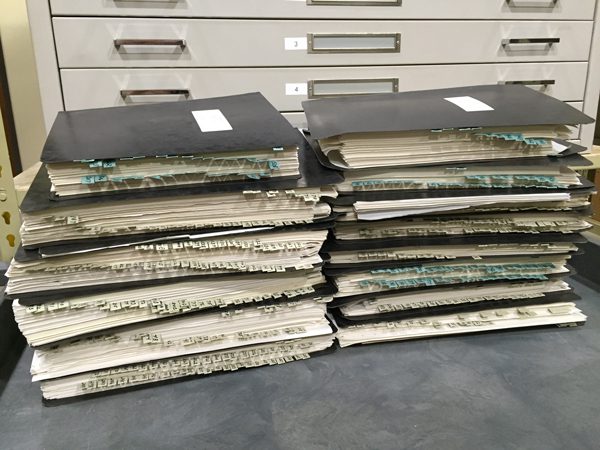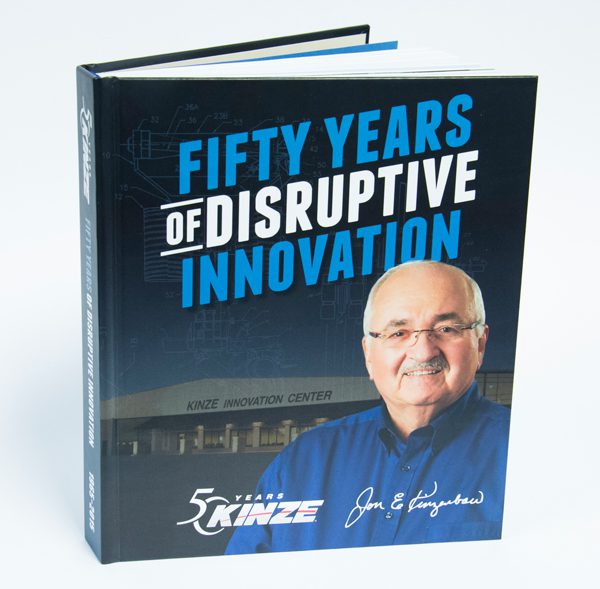Forty years ago, Kinze Manufacturing was just a small farm equipment startup near Williamsburg, Iowa. After developing several innovative products, the company was starting to attract the attention of farmers looking for ways to improve their farming efficiency. However, Kinze was also drawing the attention of the industry-giant, John Deere.
The following is the fourth installment of a five-part series describing Jon Kinzenbaw’s early battles with John Deere – both in the field and in the courtroom. What started out as suit over row unit availability, eventually ended in a ruling that forever changed Kinzenbaw’s young company – and the ag equipment industry as a whole!
This excerpt is from the book “Fifty Years of Disruptive Innovation” and is told in Jon’s own words. If you missed part one, part two or part three be sure to catch up on this blog series.
So You Think You Have a Patent
A very important practice in securing patents is that an idea must be novel and the patent must be applied for within a year of a public disclosure — meaning it must be treated as confidential. Once an outside person sees it, the one-year countdown begins. The Max Emerge™ row unit was being tested in the early 1970s with farmers, but patents were not filed for another approximately 2.5 years, after it was in the hands of dealers and customers to see how they liked it. John Deere failed to apply for its patents in a timely manner.
During the trial, there were numerous outbursts when witnesses were on the stand, and Deere’s attorneys and various Deere employees and supporters in the audience would try to coach those testifying by making loud whispers or comments. The judge would look up, but could never figure out who was doing it.
About midway through the trial, it seemed the judge had enough of the coaching and word got out that he was going to reprimand John Deere for these outbursts. The next morning, apparently unsure of what was going to happen, one of John Deere’s more outspoken attorneys stayed in the hallway and wouldn’t enter the courtroom. We observed him from inside the courtroom, standing with his hands cupped around his face looking in through the glass doors. I figure he didn’t want to be embarrassed and put on the spot if the judge was going to call him on the carpet. It was very amusing to observe this of a man who thought he was so powerful.
The judge, the Honorable Edward McManus, who originally seemed more receptive to what the Deere attorneys wanted at the start of the trial, seemed more receptive to us after he heard how Deere had deceived the U.S. Patent Office. All of a sudden, if we wanted to get a document in, he allowed it. If we wanted to say something, he allowed us to speak. Deere would object and he would overrule.

The trial went on for four weeks, and day after day, Hill and I used a shopping cart to haul our stacks of documents the three blocks between the old Roosevelt Hotel where we were staying, and the courthouse. On one particularly cold morning in March, we were standing at the stoplight waiting to cross 1st Avenue toward the courthouse. On the other side of the street, the jury was being led to the courthouse by the bailiff. The jury stood diagonally across from us on the opposite street corner. While we all waited for the lights to change, a black limo came down the street and drove between the jury and us and on up to the courthouse steps where many of Deere’s attorneys got out. There were approximately 20 attorneys plus extra clerks to help carry their documents. In contrast, I had two attorneys and helped carry my own documents. The difference between Kinze and Deere was plain for the jury to see.
At the end of the patent testimony, we went back to the hotel to wait for the verdict. It took the jury of eight Iowa citizens three days and 18 hours to reach a verdict. When the call came in, we were sitting in our hotel room. Hill had developed a chart with all of the questions, and when the magistrate called us and read them back to us, he could check each one off as either “yes” or “no” and instantly see how we were doing. Sometimes a “no” was to our favor and sometimes a “yes” was. For 13 reasons, the jury found Deere’s patents as unenforceable or invalid. We just about had to peel Hill off the ceiling. “We got every one of them with multiple strikes! They have no patents!” Hill exclaimed.
We didn’t realize that we could knock out every patent in that trial, and thought we were going to have to rely on the antitrust part of the lawsuit to avoid a verdict that we infringed the patents. We really didn’t need the antitrust part of the trial at this point. It was March 31, 1983 and Judge McManus called Hill and the Deere attorneys into his chambers and told Deere’s group, “Gentlemen, as you’re well aware, you have just lost validity for every one of your patents. Realizing it’s subject to appeals, I must remind you that tomorrow, we enter into the antitrust portion of this trial, Kinze’s day in court. Do you think that maybe you could get this thing settled and not waste another month of this jury’s and this court’s valuable time?” John Deere’s attorneys almost in unison said, “Yes, sir,” and Judge McManus gave them until four o’clock that afternoon to settle.
Hill came back to the hotel to talk about strategy. We had already come up with a dollar amount of damages for the two or three years that Deere refused to sell us row units. And I added, “I suggest that we double that number and, of course, they’ll want to negotiate. If we can get a 50 percent offer, we will be able to settle.” Hill took the numbers to Deere’s attorneys and they immediately countered with 50 percent of my number. He was shocked that Deere agreed so quickly, then wanted to know what my strategy was going to be; do we accept and move on, or do we continue to negotiate? I said, “No, let’s get a little frosting on the cake. Find out how much we have spent in attorneys’ fees and add that on.” Jim called his office and estimated the number was somewhere around $650,000. So we added that on top of their offer.
They were reluctant to give me the attorney fees. They said they didn’t have the clearance to spend that extra money and Deere’s CEO was unreachable on an international flight. However, I knew it wasn’t the money. I believe Deere’s attorneys were more concerned with language and didn’t want the public to find out what the company had done. Hill told me, “You know, we really don’t need the newspapers blasting this all over, anyway.” So we left Deere a chance to save face, and offered a secret settlement. Deere also reserved the right to appeal its patents. But 4 p.m. came and went, and we were still talking about the language. They called the judge, who gave them four more hours. So, back and forth went the memos, and everybody was in a lather trying to get this thing hammered out.
It was awfully tempting to just settle right then and there, but it was a matter of principle, and it made me mad — madder than mad. Deere had excuse after excuse, and I finally said in disgust, “OK. You just keep your money and we’ll see you tomorrow morning in court.” Hill looked at me and said, “That’s a bold move.” “Well,” I said, “if we go in the courtroom, we also stand a chance of getting triple damages, and we’re off to a good start.”
The Story Continues

Stay tuned for the next installment of the John Deere v. Kinze series to come out in the next couple of weeks.
Can’t wait for the rest of the story? The remainder of this story and many more are told in the book “Fifty Years of Disruptive Innovation”, which can be purchased on Amazon or in the Kinze Store.
